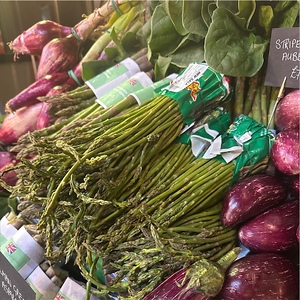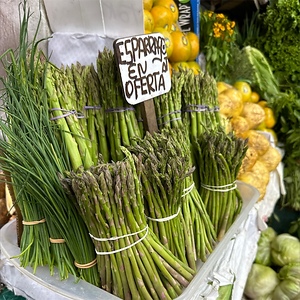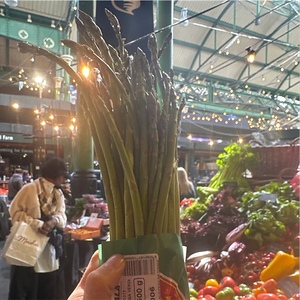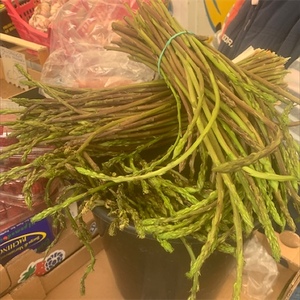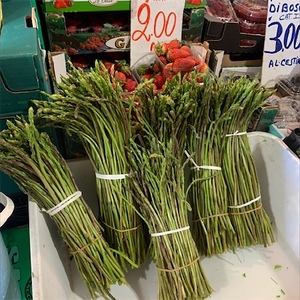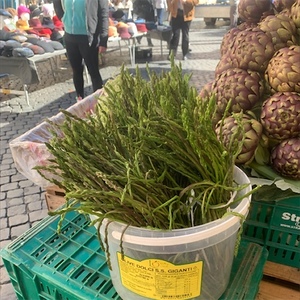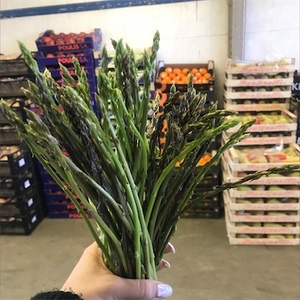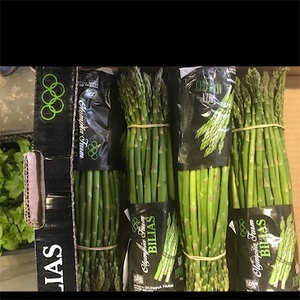

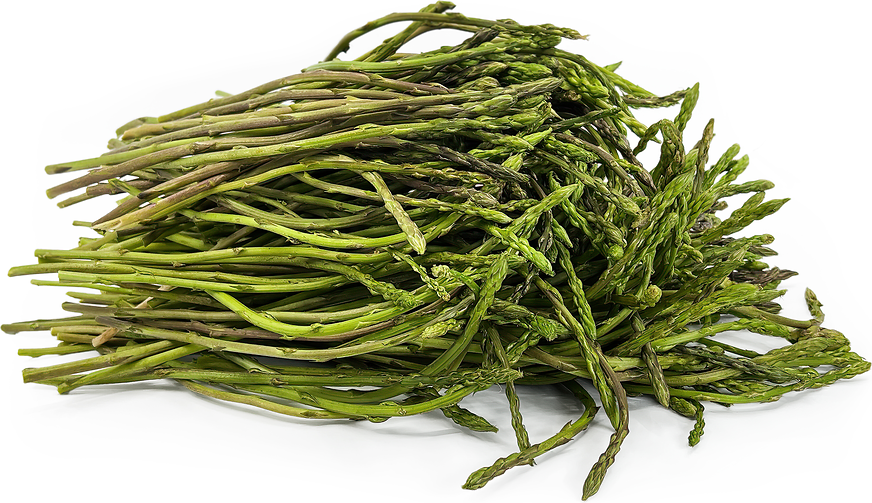
Wild Asparagus
Estimated Inventory, lb : 0
Description/Taste
Wild asparagus varies in size depending on the species and maturity at harvest. It has an elongated, slender, and spindly appearance and averages 10 to 60 centimeters in length. In most Mediterranean markets, the spears are collected when they are 10 to 20 centimeters in length for a more tender consistency. Each spear has a thin, narrow, and delicate appearance, ranging from straight to slightly curved, and is often bent toward the top. The spears also feature feathery, tapered, branched foliage and spine-like leaves along the stalk with a semi-soft feel. Wild asparagus showcases variegated shades of muted, dark green to purple hues, changing with each species, and has a taut, lightly textured, and pliable consistency. Underneath the surface, the spears have firm, succulent, snappy flesh with a slightly stringy, chewy, and crisp nature, softening once heated. Wild asparagus is primarily consumed cooked and has a grassy, green aroma. The flesh has an herbaceous, vegetal, earthy, and green flavor with bitter, subtly sweet, and faintly nutty nuances.
Seasons/Availability
Wild asparagus is available from late winter through early summer, with a peak season in February and March. Depending on the weather and climate each year, Wild asparagus spears can also appear in the fall in some regions of Italy.
Current Facts
Wild asparagus, botanically a part of the Asparagus genus, is a category of several species foraged from natural landscapes belonging to the Asparagaceae family. The Asparagus genus contains over 300 species, and several species are classified as wild, including Asparagus acutifolius, Asparagus prostrates, Asparagus racemosus, and Asparagus corruda. Many of these wild species vary in appearance, taste, and habitat, but in general, Wild asparagus species are thinner and stronger in flavor than cultivated asparagus. Wild asparagus is an evergreen perennial seasonally foraged, especially throughout the Mediterranean, as a culinary delicacy. The edible spears have been collected from wild populations since ancient times and have been recorded throughout history for their medicinal, culinary, and folkloric uses. Wild asparagus was once a food source cherished for its ability to grow in poor soils and appear in the same location each year. Seasonal asparagus collecting was often a guarded activity, as many foragers fiercely protected their gathering spots to ensure they would not be overharvested. Wild asparagus spears also frequently hide beneath undergrowth, making them initially challenging to spot. The spears are only available for a few months each year and provide a nutritional and flavorful food source. When in season, Wild asparagus is gathered and sold through fresh markets in its growing regions. Many of the wild species are collectively sold under the Wild asparagus name, and they are also known as Sparaggi and Agria sparaggia in Greece, Sparacelli, Sparacogne, and Asparagi selvatici in Italy, Asperge sauvage in France, and Espárrago triguero and Espàrrec silvestre in Spain. The spears are an anticipated seasonal ingredient and have remained a treasured wild plant among communities in the Mediterranean.
Nutritional Value
Wild asparagus will vary in nutritional content, depending on the specific species. In general, it is a source of fiber to regulate the digestive tract, vitamin A to maintain healthy organs, iron to develop the protein hemoglobin for oxygen transport through the bloodstream, and calcium to protect bones and teeth. Wild asparagus also provides potassium to balance fluid levels within the body, vitamin E to protect the cells against free radical damage, magnesium to control nerve functions, vitamin C to boost the immune system, and other nutrients, including vitamin K, zinc, phosphorus, folate, B vitamins, and manganese. In ancient natural medicines practiced throughout the Mediterranean, Wild asparagus was often viewed as a diuretic, and the water from boiling the spears was consumed as a cleansing drink to remove toxins from the body. Lemon and salt were also added to the mixture for increased detoxifying properties and as a method to improve skin complexion.
Applications
Wild asparagus has an earthy, green, herbaceous, and subtly bitter taste suited for cooked preparations. Some communities in the Mediterranean will eat the young and tender spears raw in salads, but most documented preparations involve cooking the spears to remove bitterness. Wild asparagus spears should be washed, and the woody ends should be snapped or sliced from the base before cooking. Once prepped, the spears are popularly blanched in salted water and then placed in an ice bath to retain their coloring. Blanched Wild asparagus is tossed into salads or coated in savory sauces as a simple side dish. One of the most prevalent uses for Wild asparagus throughout the Mediterranean is pairing the spears with eggs. Cooking Wild asparagus into frittatas, omelets, scrambles, and quiche are popular recipes featured across France, Italy, Spain, and Greece. The spears are also cooked and served with parboiled eggs or steamed, tossed in olive oil and lemon juice, and served with hardboiled eggs and bread. In Italy, Wild asparagus is cooked and served in various pasta dishes, pureed and stuffed into ravioli, used as a pizza topping, or incorporated into risotto. They are also wrapped in cheese and prosciutto, baked in the oven, or cooked and blended into pesto. In Greece, Wild asparagus is added to fritters, preserved in oil, simmered in stews, combined into pie fillings, or cooked with broccoli and scallions. The spears are also served with octopus. Wild asparagus is commonly found in springtime soups, and in France, it is rumored that Madame de Maintenon, the second wife of King Louis XIV, prepared asparagus in a famous soup. Wild asparagus pairs well with bacon, prosciutto, sausage, cheeses such as parmesan, ricotta, pecorino, and caciocavallo, herbs such as basil, thyme, chervil, parsley, and oregano, and aromatics, including garlic, shallots, and spring onions. Wild asparagus should be immediately consumed after harvest for the best quality and flavor. The shoots will last up to three days when stored in the refrigerator and are often trimmed and placed in a jar with water to ensure hydration. They are also wrapped in a damp towel or blanched and frozen for extended use.
Ethnic/Cultural Info
Wild asparagus is featured in several legends in Greek mythology. Asparagus was often connected to Aphrodite, the goddess of love, sexuality, and beauty. The spear’s distinct shape and upright growing habits symbolized fertility, and as an act of worship, they were offered to Aphrodite at her temples. Wild asparagus was also used among the Boeotians, a people group in Ancient Greece. It is said that the Boeotians would create a chaplet or a wreath worn around the head for the bride to wear on her wedding day. This chaplet was sometimes made of asparagus, as the spears symbolized dedication and determination. The Boeotians believed that asparagus plants were often thorny and challenging to handle at times, but their edible spears were a flavorful delicacy. This represented the new marriage, and if the couple perseveres together through hard times, their marriage will become sweet and rewarding.
Geography/History
Wild asparagus is thought to be native to regions of the Eastern Mediterranean and Asia Minor, commonly known as Anatolia in the modern day. Experts often dispute the exact site of origin as several wild species are found throughout Europe, North Africa, and Asia Minor with varying histories. Ancient forms of Wild asparagus were first seen on an Egyptian frieze, a wall painting or sculpture, dating back to 3,000 BCE. Wild asparagus was also documented throughout medicinal, culinary, and cultural texts in Ancient Greece and Rome, and the Romans were one of the first communities to cultivate the wild plants. Wild asparagus also expanded along trade routes and naturalized in other parts of the Mediterranean, including France and Spain. Historically, Wild asparagus was a foraged delicacy among common social classes and was later given to nobility throughout the Mediterranean as a culinary ingredient. In the 16th century, King Louis XIV of France was reported to have been fond of asparagus and constructed greenhouses to cultivate and grow spears year-round. The rise in asparagus’ use among all social classes led to it becoming a recognized culinary and medicinal plant in the 16th century in Europe. Cultivated versions of Wild asparagus became categorized as Asparagus officinalis or garden asparagus, and in the 18th century, larger, fleshier spears were bred for improved cultivation. Asparagus officinalis was later planted in North America through European settlers in the 17th and 18th centuries and the species eventually escaped cultivation, becoming naturalized. It is important to note that while these naturalized populations in North America are often called wild, they are better classified as feral since they are not native. Wild asparagus is still naturally found in its native growing regions across Europe, Northern Africa, and Western Asia. The seasonal spears appear in many different landscapes, including meadows, alongside streams, thickets, fields, rocky slopes, and uncultivated land. Wild asparagus has also become semi-wild in the Mediterranean as it has also been purposely planted on farmland and in olive groves as a secondary source of income. When in season, Wild asparagus is sold through local markets in its growing region or is foraged and consumed for home culinary purposes.
Recipe Ideas
Recipes that include Wild Asparagus. One
Podcast



